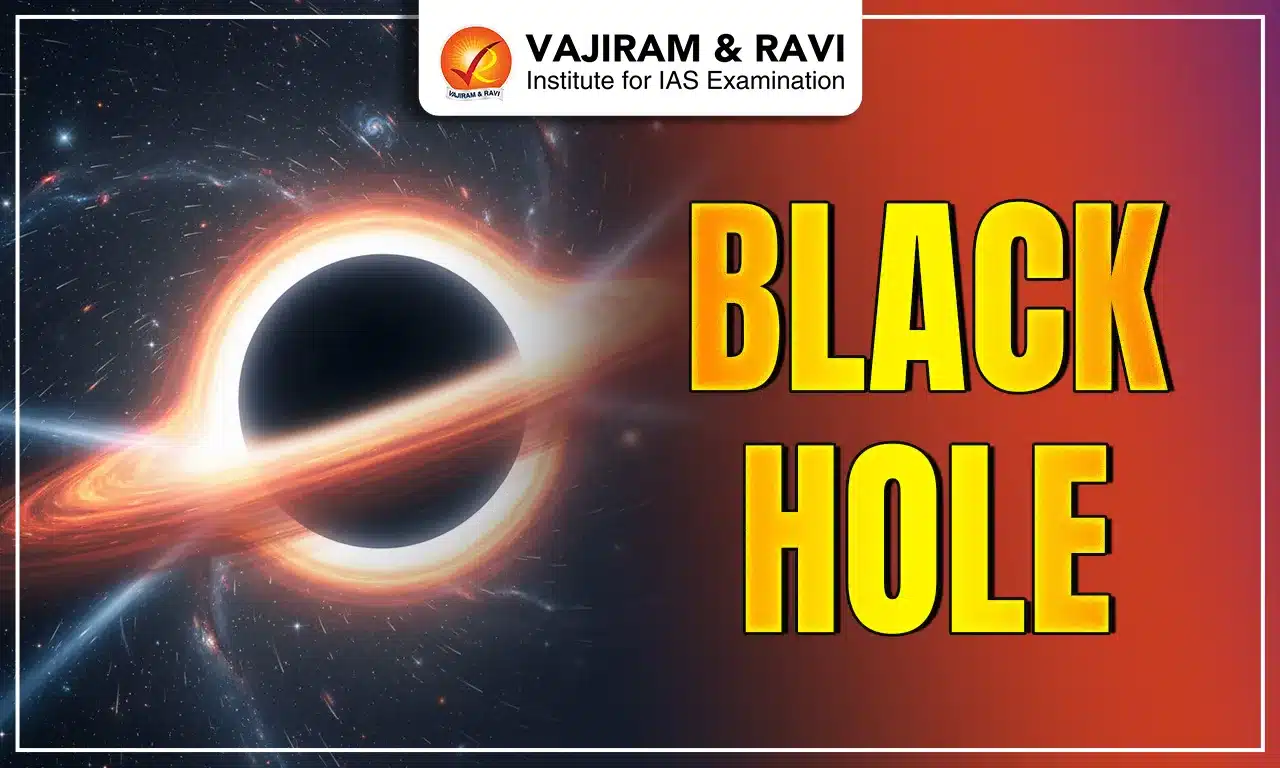Black holes are formed after the supernova explosion when the core of a massive dying star more than 2.5 times the mass of the Sun collapses until an infinite density where gravity is so high that even light cannot escape. Predicted by Einstein, through his general relativity theory which says that a sufficiently compact mass can bend spacetime and create a black hole, its theoretical structure was prepared independently by Tolman, Oppenheimer, Volkoff and S. Chandrasekhar.
Black holes, with their extreme gravitational pull and unique properties, play a significant role in various aspects of astrophysics and cosmology.
About Black Hole
The discovery of the Black Hole started with the discussion on objects with gravitational fields that are too powerful for light to escape by John Michell and Pierre-Simon Laplace in the 18th century. Later several, efforts were made in this direction:
- David Finkelstein (1958): Coined the term “black hole” to describe a region in space where nothing can escape.
- LIGO and Virgo Collaboration (2016): Announced the first direct detection of gravitational waves, confirming a black hole merger.
- Event Horizon Telescope (2017): Studied the supermassive black hole in Messier 87’s centre.
- First Black Hole Image (10 April 2019): Event Horizon Telescope released the first direct image of a black hole and its surroundings.
- Closest Known Black Hole (As of 2021) is located about 1,500 light-years (460 parsecs) away.
Anatomy of a Black Hole

- Event horizon: The boundary around a black hole beyond which nothing can escape, not even light. It's the point of no return.
- Singularity: The core of the black hole where all its mass is concentrated. At this point, density and gravity are thought to be infinitely large, and the laws of physics as we know them cease to operate.
- Accretion disk: When a black hole pulls in matter from a nearby star or gas cloud, this matter forms a rotating disk around the black hole, known as an accretion disk.
- Particle Jets: Some black holes emit powerful jets of particles and radiation from their poles. These jets can extend for thousands of light-years.
- Hawking radiation: A theoretical prediction by Stephen Hawking that black holes can emit radiation due to quantum effects near the event horizon. This radiation could eventually lead to the evaporation of the black hole over extremely long timescales.
- Gravitational Time dilation: Near a black hole, time passes slower due to its intense gravitational field, as predicted by Einstein's theory of general relativity.
- Information Paradox: A theoretical dilemma concerning what happens to information about matter that falls into a black hole. It questions whether information is lost or preserved, challenging principles of quantum mechanics.
Significance of Black Hole
They have a significant role in various aspects of astrophysics and astronomy. These include:
- Insights into Stellar evolution: The formation and evolution of stellar black holes offer valuable information about the life cycles of massive stars and supernova mechanics.
- Galaxy dynamics and evolution: Supermassive black holes at the centres of galaxies significantly influence the dynamics and evolution of their host galaxies, affecting star formation rates and the distribution of matter.
- Supermassive black holes power the Active Galactic Nuclei (AGN), which are extremely luminous regions found at the centres of some galaxies. They are among the brightest and most energetic objects in the universe.
- Gravitational wave astronomy: The merging of black holes is a primary source of gravitational waves, offering a new way to observe and understand the universe, complementing traditional electromagnetic observations.
- Testing quantum mechanics: The study of black holes, particularly the information paradox, challenges and refines our understanding of quantum mechanics.
Albert Einstein and Black Holes
Albert Einstein laid the foundation for the conceptual and mathematical framework that led to the prediction and eventual confirmation of black holes. His theory predicts that massive objects can warp spacetime which acts as the fundamental cause of the phenomena attributed to black holes. His theory also predicted singularity.
Formation of Black Holes

They are formed from the remnants of massive stars or through other high-energy processes. The process of formation of Black holes includes:
- Stellar Life Cycle: A star spends most of its life fusing hydrogen into helium in its core, a process that releases enormous amounts of energy and provides the outward pressure necessary to counterbalance the star's immense gravitational pull.
- Exhaustion of Nuclear Fuel: As the star consumes its nuclear fuel, it undergoes various stages of fusion, depending on its mass. Heavier elements are formed in the core through fusion, up to iron in the most massive stars.
- Core Instability: Once the core's fusion process produces iron, it no longer generates energy to support the star against gravitational collapse. This is because iron fusion consumes energy rather than releasing it, leading to a loss of equilibrium in the star's core.
- Supernova Explosion: The core's collapse triggers a supernova, an incredibly powerful explosion. The outer layers of the star are blown away into space, leaving behind the core.
- Core Collapse: What happens next depends on the mass of the remaining core:
- If the core is less than about 2.5 times the mass of the Sun (the Tolman-Oppenheimer-Volkoff limit), it will likely form a neutron star.
- If the core's mass exceeds this limit, its gravity overwhelms all other forces, and it continues to collapse.
- Formation of a Black Hole: The core collapses to a point of infinite density, known as a singularity, where the laws of physics as we currently understand them break down. The gravitational pull becomes so strong that not even light can escape, forming a black hole.
- Event Horizon Formation: Around the singularity, an event horizon forms, which is the boundary beyond which nothing can escape the black hole's gravitational pull. The size of the event horizon, or the Schwarzschild radius, depends on the mass of the black hole.
Detection of the Black Hole

The detection of black holes is a multifaceted approach that combines observations across various wavelengths and techniques. Methods to detect rely on observing the effects black holes have on their surroundings. Several methods of detection are:
- Accretion disk observation: It can be detected by space-based telescopes.
- Gravitational influence on nearby objects: The gravitational pull affects the orbit of these objects, often causing them to move faster.
- Gravitational Lensing: This phenomenon occurs when the intense gravity of a black hole bends the light from a more distant object behind it.
- Gravitational Waves Detection: The collision and merging of two black holes generate gravitational waves, ripples in spacetime that can be detected by observatories like LIGO and Virgo.
- Event Horizon Telescope (EHT): The EHT project uses a network of radio telescopes around the world to create a virtual Earth-sized telescope, capable of observing the event horizon of a supermassive black hole.
- X-Ray binaries: In systems where a black hole is paired with a normal star, the strong gravity of the black hole can strip matter from the star.
- Gamma-ray bursts: Some theories suggest that certain types of gamma-ray bursts, extremely energetic explosions detected in distant galaxies, are associated with the formation of black holes.
- Spectral line broadening: The intense gravity of a black hole can affect the light emitted from the matter around it, causing a broadening of spectral lines that can be detected through spectroscopic methods.
Types of Black Holes

They are of different types, primarily based on their mass and the process of their formation.
- Stellar Black Holes: These are often identified by observing the high-energy phenomena that occur as they interact with other stars or accrete matter from their surroundings.
- Supermassive Black Holes: They play a crucial role in the formation and evolution of galaxies, influencing star formation and galaxy dynamics.
- Intermediate Black Holes: They are of great interest to astronomers as they could provide a missing link in our understanding of black hole evolution.
- Primordial Black Holes: They could offer insights into the conditions of the early universe and the nature of dark matter.
Last updated on November, 2025
→ Check out the latest UPSC Syllabus 2026 here.
→ Join Vajiram & Ravi’s Interview Guidance Programme for expert help to crack your final UPSC stage.
→ UPSC Mains Result 2025 is now out.
→ UPSC Notification 2026 is scheduled to be released on January 14, 2026.
→ UPSC Calendar 2026 is released on 15th May, 2025.
→ The UPSC Vacancy 2025 were released 1129, out of which 979 were for UPSC CSE and remaining 150 are for UPSC IFoS.
→ UPSC Prelims 2026 will be conducted on 24th May, 2026 & UPSC Mains 2026 will be conducted on 21st August 2026.
→ The UPSC Selection Process is of 3 stages-Prelims, Mains and Interview.
→ UPSC Result 2024 is released with latest UPSC Marksheet 2024. Check Now!
→ UPSC Prelims Result 2025 is out now for the CSE held on 25 May 2025.
→ UPSC Toppers List 2024 is released now. Shakti Dubey is UPSC AIR 1 2024 Topper.
→ UPSC Prelims Question Paper 2025 and Unofficial Prelims Answer Key 2025 are available now.
→ UPSC Mains Question Paper 2025 is out for Essay, GS 1, 2, 3 & GS 4.
→ UPSC Mains Indian Language Question Paper 2025 is now out.
→ UPSC Mains Optional Question Paper 2025 is now out.
→ Also check Best IAS Coaching in Delhi
Black Hole FAQs
Q1. What is a Black Hole?+
Q2. How are Black Holes Formed?+
Q3. What is the Event Horizon of a Black Hole?+
Q4. What Happens Inside a Black Hole?+
Q5. What are Supermassive Black Holes?What are Supermassive Black Holes?+
Tags: black hole quest

















